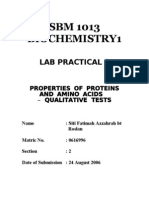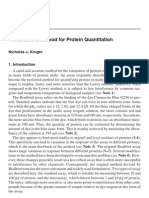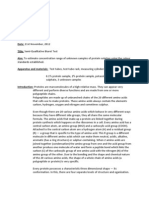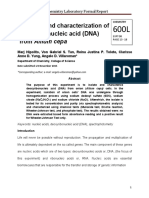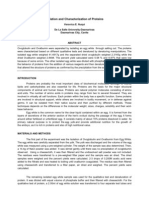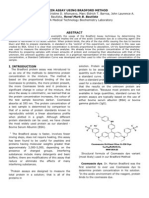Formal Report Bio Chem 1
Formal Report Bio Chem 1
Uploaded by
yel_reyesCopyright:
Available Formats
Formal Report Bio Chem 1
Formal Report Bio Chem 1
Uploaded by
yel_reyesCopyright
Available Formats
Share this document
Did you find this document useful?
Is this content inappropriate?
Copyright:
Available Formats
Formal Report Bio Chem 1
Formal Report Bio Chem 1
Uploaded by
yel_reyesCopyright:
Available Formats
DETERMINING THE CONCENTRATION OF THE UNKNOWN PROTEIN SOLUTION THROUGH BRADFORD ASSAY
AUTHORS
Marisse De Leon, Sarah De Los Santos, Heidy De Mesa, Estellito Dela Cruz, Gabrielle Delos Reyes Group 3, 2D-Pharmacy, Faculty of Pharmacy, University of Santo Tomas
ABSTRACT
The Bradford protein assay is a spectroscopic analytical procedure used to measure the concentration of protein in a solution. The objective of the experiment is to determine the concentration of the unknown protein solution and to draw the standard curve by plotting the 595nm against a reagent blank. Standards were prepared by adding 0.3 and 0.4mL of BSA stock solution. Distilled water was added to each of the test tube to bring the volume to 1mL. For the determination of the unknown concentration, 1mL of the unknown protein sample was used. Through the use of the spectrophotometer, the absorbances (in nm) for the unknown proteins were determined. A standard curve was drawn by plotting the A595 versus the BSA concentration. The concentrations of the unknown proteins were solved by using linear regression. The result obtained for the concentration of the unknown for trials 1 and 2 are 106.117g/mL and 88.335g/mL. The average concentration is 97.226g/mL. The average absorbance is 0.2929nm
INTRODUCTION
There is no single protein assay method that yields absolutely accurate results. The only true andaccurate method for determining protein concentration is by acid hydrolyzing a portion of the sample and then carries out amino acid analysis on the hydrolyzate. But, this method is time-consuming. Eachmethod and assay has its own disadvantage and limitations.The most commonly used assays are the Ultraviolet Absorbance, Lowry Assay, BCA assay andthe Bradford Assay. The UV absorbance monitors the absorbance of aromatic amino acids, tyrosine andtryptophan or if the wavelength is lowered, the absorbance of the peptide bond. It is quick, with the samples that can be recovered. But, it is also highly susceptible to contamination by buffers, biologicalmaterials and salts. The Lowry Assay or enhanced copper since it reduces Cu +2 to Cu +1, sensitive over awide range and is the most commonly referenced procedure for protein determination but, it also takes aconsiderable amount of time. And the BCA assay or the bicinchoninic acid which is less susceptible toi n t e r f e r e n c e f r o m c o m m o n b u f f e r
substance and is very sensitive and rapid if you use elevated temperatures, but, the reaction does not go to completion when performed at room temperature and dilution is often necessary for concentrated protein samples The Bradford assay, a colorimetric protein assay, is based on an absorbance shift of the dye Coomassie Brilliant Blue G-250 in which under acidic conditions the red form of the dye is converted into its bluer form to bind to the protein being assayed. During the formation of this complex, two types of bond interaction take place: the red form of Coomassie dye first donates its free electron to the ionizable groups on the protein, which causes a disruption of the protein's native state, consequently exposing its hydrophobic pockets. These pockets on the protein's tertiary structure bind non-covalently to the non-polar region of the dye via van der Waals forces, positioning the positive amine groups in proximity with the negative charge of the dye. The bond is further strengthened by the ionic interaction between the two. The binding of the protein stabilizes the blue form of the Coomassie dye; thus the amount of the complex present in solution is a measure for the protein
You might also like
- Protein Assay Using Bradford MethodDocument3 pagesProtein Assay Using Bradford MethodRaymond Malubay100% (2)
- Protein Assay Using The Bradford MethodDocument3 pagesProtein Assay Using The Bradford MethodTimmy CoNo ratings yet
- Protein Assay Using The Bradford Method: B. Procedure 1. Preparation of The SolutionDocument3 pagesProtein Assay Using The Bradford Method: B. Procedure 1. Preparation of The SolutionNaim Garcia MacasalongNo ratings yet
- Lab 3 Biuret Protein AssayDocument9 pagesLab 3 Biuret Protein Assayapi-384770852No ratings yet
- Lab Report Sds-Page WB - PT 1 (1-5)Document5 pagesLab Report Sds-Page WB - PT 1 (1-5)Ezad juferiNo ratings yet
- Effect of Substrate Concentration on α -AmylaseDocument26 pagesEffect of Substrate Concentration on α -Amylasepriyaa100% (5)
- Protein Electrophoresis LabDocument8 pagesProtein Electrophoresis LabMarie St. Louis100% (1)
- Bradford Protein Concentration Assay Formal ReportDocument4 pagesBradford Protein Concentration Assay Formal ReportAngeline Limpiada100% (1)
- Protein Assay by The Bradford MethodDocument4 pagesProtein Assay by The Bradford MethodKat Buenaflor100% (1)
- A Laboratory Manual of Physical PharmaceuticsFrom EverandA Laboratory Manual of Physical PharmaceuticsRating: 2.5 out of 5 stars2.5/5 (2)
- Sons and Daughters of God: The Believer's Identity, Calling, and Destiny PDFDocument74 pagesSons and Daughters of God: The Believer's Identity, Calling, and Destiny PDFjoshuagnanasekarNo ratings yet
- Formal Report - BradfordDocument2 pagesFormal Report - BradfordAly Arcega100% (4)
- Exp 3 - Bradford AssayDocument7 pagesExp 3 - Bradford AssayracelanjelicaNo ratings yet
- Quantitative Determination of Proteins Using Bradford MethodDocument2 pagesQuantitative Determination of Proteins Using Bradford Methodann_michelle7No ratings yet
- Bradford Protein Assay: Considerations For UseDocument4 pagesBradford Protein Assay: Considerations For UseRaja RajeshwariNo ratings yet
- BiochemistryDocument5 pagesBiochemistryAngeline LimpiadaNo ratings yet
- Bradford ReportDocument7 pagesBradford ReportNOXOLO NOMBULELO WENDY NGXONGONo ratings yet
- Bradford Formal ReportDocument4 pagesBradford Formal ReportAlyana100% (1)
- EXPT 2 LAB REPORT Extraction and Characterization of Proteins Group 2Document11 pagesEXPT 2 LAB REPORT Extraction and Characterization of Proteins Group 2Teach LesnitoNo ratings yet
- The Analysis Techniques of Amino Acid and Protein in Food and Agricultural ProductsDocument8 pagesThe Analysis Techniques of Amino Acid and Protein in Food and Agricultural ProductsMashuri UtamaNo ratings yet
- Lab Report 5 FEER - Sem2Document14 pagesLab Report 5 FEER - Sem2Feer NordinNo ratings yet
- Biochem 313 Prac 5Document8 pagesBiochem 313 Prac 5Anonymous G8WVOfRqV100% (2)
- Lab Report Exp.6Document8 pagesLab Report Exp.6Qj B PdkhNo ratings yet
- Protein Lab ReportDocument7 pagesProtein Lab ReportFariha0% (1)
- Triple Sugar Iron AgarDocument3 pagesTriple Sugar Iron AgarmaniNo ratings yet
- The Bradford Method For Protein QuantitationDocument7 pagesThe Bradford Method For Protein QuantitationChemiboyNo ratings yet
- Amino Acids and ProteinsDocument9 pagesAmino Acids and ProteinsZari NovelaNo ratings yet
- Total Protein Determination: Unit Intended Learning OutcomesDocument12 pagesTotal Protein Determination: Unit Intended Learning OutcomesMaria ClaraNo ratings yet
- Sutherland 1991Document7 pagesSutherland 1991Isal AbdussalamNo ratings yet
- Bradford Protein AssayDocument3 pagesBradford Protein AssayFarhan AhmadNo ratings yet
- Sigma BCA Protein Assay ProtocolDocument6 pagesSigma BCA Protein Assay ProtocolssmaniNo ratings yet
- DNA Quality-Spectrophotometry and ElectrophoresisDocument5 pagesDNA Quality-Spectrophotometry and Electrophoresislovina candra kirana100% (1)
- Biology Lab - Biuret TestDocument7 pagesBiology Lab - Biuret TestZoe Bradshaw0% (1)
- BCH 314 Tutorial 1Document9 pagesBCH 314 Tutorial 1victorNo ratings yet
- Question 1 (37 Marks) : Biochemistry 3 BCH 314Document4 pagesQuestion 1 (37 Marks) : Biochemistry 3 BCH 314victorNo ratings yet
- Enzyme KineticsDocument8 pagesEnzyme KineticsKaren Ivy Bacsain100% (1)
- SDS-PAGE of Protein: BT 510 Analytical Biotechnology LabDocument6 pagesSDS-PAGE of Protein: BT 510 Analytical Biotechnology LabBarish RoyNo ratings yet
- DNA ExtractionDocument18 pagesDNA ExtractionUmmi MahmudahNo ratings yet
- Estimation of AlbuminDocument2 pagesEstimation of AlbuminAnand VeerananNo ratings yet
- Size Exclusion Column ChromatographyDocument8 pagesSize Exclusion Column ChromatographySmeetha Kaur100% (1)
- Enzyme Lab Report FinalDocument6 pagesEnzyme Lab Report Finalrsenser2100% (2)
- EXP5CHEM26Document12 pagesEXP5CHEM26Albert Romano ObisNo ratings yet
- Bacterial Optical Density MeasurementsDocument4 pagesBacterial Optical Density Measurementskrishnarao2010No ratings yet
- DNA Formal ReportDocument11 pagesDNA Formal ReportAngelo Dela Cruz Villaroman100% (3)
- Lab ReportDocument7 pagesLab ReportAlliedschool DefencecampusNo ratings yet
- BCA Method of Protein EstimationDocument31 pagesBCA Method of Protein EstimationSwetha SundarNo ratings yet
- Biuret Protein Assay f18Document6 pagesBiuret Protein Assay f18new worldNo ratings yet
- Gel FiltrationDocument123 pagesGel FiltrationZulfikri Asmardi RaufNo ratings yet
- Report Reducing SugarDocument8 pagesReport Reducing SugarRedzuan Hussin83% (6)
- Lowry AssayDocument7 pagesLowry AssayGrace AquinoNo ratings yet
- Polyphenol Oxidase Activity of BananasDocument5 pagesPolyphenol Oxidase Activity of BananasVictor Nyarugwe100% (3)
- Sds PageDocument20 pagesSds Pageviswagithe s lNo ratings yet
- Experiment 2 Isolation and Characterization of Proteins Protein Assay Using The Bradford MethodDocument7 pagesExperiment 2 Isolation and Characterization of Proteins Protein Assay Using The Bradford MethodCHRISTIN SCHLITTNo ratings yet
- Tyra Nelson FINAL Total Glycated HaemoglobinDocument7 pagesTyra Nelson FINAL Total Glycated HaemoglobinK WNo ratings yet
- Restriction LabDocument8 pagesRestriction Labtworedpartyhats100% (3)
- Isolation and Characterization of ProteinsDocument3 pagesIsolation and Characterization of ProteinsVern NuquiNo ratings yet
- Dna - FR 8 & 9Document6 pagesDna - FR 8 & 9Tatocat100% (1)
- Production of Pyruvate and AcetaldehdeDocument6 pagesProduction of Pyruvate and AcetaldehdeVictor Nyarugwe67% (3)
- BradfordDocument3 pagesBradfordBien Emilio B NavarroNo ratings yet
- Protein Assay Using Bradford MethodDocument3 pagesProtein Assay Using Bradford MethodRonel Mark BautistaNo ratings yet
- Experiment 2 Isolation and Characterization of Proteins (Protein Assay Using The Bradford Method)Document8 pagesExperiment 2 Isolation and Characterization of Proteins (Protein Assay Using The Bradford Method)Kwien AustriaNo ratings yet
- Nicolas Besly - Tom Goldsmith - Robert Rogers - Array - Array - How Parliament Works (2019) - Libgen - LiDocument459 pagesNicolas Besly - Tom Goldsmith - Robert Rogers - Array - Array - How Parliament Works (2019) - Libgen - LiZoe Williams100% (1)
- Farhan ButtDocument4 pagesFarhan ButtFarhan ButtNo ratings yet
- SIALOGRAPHYDocument10 pagesSIALOGRAPHYMithun JithNo ratings yet
- Zno WritingDocument40 pagesZno WritingНаталія Галамага100% (2)
- The Call of The WildDocument2 pagesThe Call of The Wildarinavardanyan13No ratings yet
- The Radiance of Dailiness: Don Delillo and The Everyday BookDocument8 pagesThe Radiance of Dailiness: Don Delillo and The Everyday BookMark SampleNo ratings yet
- MasturbationDocument19 pagesMasturbationLA Laguit100% (1)
- Calgary - Reference - PackageDocument4 pagesCalgary - Reference - PackagegiyuhjvNo ratings yet
- Elementary Social Studies CurriculumDocument34 pagesElementary Social Studies CurriculumMaricar Torres RamirezNo ratings yet
- Assignment On SC and VADocument12 pagesAssignment On SC and VAVixen Aaron EnriquezNo ratings yet
- AmazingRooftops-3-TR-AssessmentPackage INGLES 3 PRIMARIADocument24 pagesAmazingRooftops-3-TR-AssessmentPackage INGLES 3 PRIMARIABelen Martin Julian MartinNo ratings yet
- Clientele & Audiences in Social WorkDocument6 pagesClientele & Audiences in Social WorkIssaVillanuevaNo ratings yet
- 623Document304 pages623mylan_ScribdNo ratings yet
- Right Brain Exercises To StimulRight Brain Exercises To Stimulate Creative Thoughtate Creative ThoughtDocument3 pagesRight Brain Exercises To StimulRight Brain Exercises To Stimulate Creative Thoughtate Creative ThoughtbalasukNo ratings yet
- 01 Activity 1Document2 pages01 Activity 1Elnel TolibasNo ratings yet
- BBA SAMPLE PAPER No 1 PDFDocument16 pagesBBA SAMPLE PAPER No 1 PDFKajal DawarNo ratings yet
- Syntax PPT LectureDocument10 pagesSyntax PPT LectureMaxpein AbiNo ratings yet
- Manual Del Controlador CNC PDFDocument147 pagesManual Del Controlador CNC PDFMauricio FernandoNo ratings yet
- Continuing GuaranteeDocument13 pagesContinuing GuaranteeKarthik RickyNo ratings yet
- Chap.5 FINANCIAL ASSET ValuationDocument39 pagesChap.5 FINANCIAL ASSET ValuationJeanette FormenteraNo ratings yet
- SOA Exam CDocument6 pagesSOA Exam CNoDriverNo ratings yet
- Oracle EPM 11.1.2.4 New Features in BriefDocument10 pagesOracle EPM 11.1.2.4 New Features in BriefRamu PentapatiNo ratings yet
- Otorhinolaryngology Mnemonics by Medica Study CenterDocument27 pagesOtorhinolaryngology Mnemonics by Medica Study CenterPrekshi 1808No ratings yet
- Manual-FanTestic Integrity (NFPA)Document22 pagesManual-FanTestic Integrity (NFPA)Salley BukhariNo ratings yet
- PPTDocument30 pagesPPTAimanNo ratings yet
- Regulating Act of 1773Document4 pagesRegulating Act of 1773shambhaviNo ratings yet
- Casil Vs CaDocument8 pagesCasil Vs CaSamantha BaricauaNo ratings yet
- Canadian Charter of Rights and FreedomsDocument9 pagesCanadian Charter of Rights and FreedomsDeepa TailorNo ratings yet






















